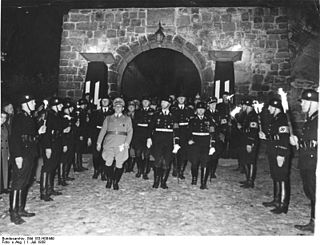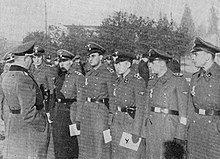
The Geheime Staatspolizei, abbreviated Gestapo, was the official secret police of Nazi Germany and in German-occupied Europe.

Reinhard Tristan Eugen Heydrich was a high-ranking German SS and police official during the Nazi era and a principal architect of the Holocaust.

The Schutzstaffel was a major paramilitary organisation under Adolf Hitler and the Nazi Party in Nazi Germany, and later throughout German-occupied Europe during World War II.
Sicherheitsdienst, full title Sicherheitsdienst des Reichsführers-SS, or SD, was the intelligence agency of the SS and the Nazi Party in Nazi Germany. Established in 1931, the SD was the first Nazi intelligence organization and the Gestapo was considered its sister organization through the integration of SS members and operational procedures. The SD was administered as an independent SS office between 1933 and 1939. That year, the SD was transferred over to the Reich Security Main Office, as one of its seven departments. Its first director, Reinhard Heydrich, intended for the SD to bring every single individual within the Third Reich's reach under "continuous supervision".

Einsatzgruppen were Schutzstaffel (SS) paramilitary death squads of Nazi Germany that were responsible for mass murder, primarily by shooting, during World War II (1939–1945) in German-occupied Europe. The Einsatzgruppen had an integral role in the implementation of the so-called "Final Solution to the Jewish question" in territories conquered by Nazi Germany, and were involved in the murder of much of the intelligentsia and cultural elite of Poland, including members of the Catholic priesthood. Almost all of the people they murdered were civilians, beginning with the intelligentsia and swiftly progressing to Soviet political commissars, Jews, and Romani people, as well as actual or alleged partisans throughout Eastern Europe.

The Reich Security Main Office was an organization under Heinrich Himmler in his dual capacity as Chef der Deutschen Polizei and Reichsführer-SS, the head of the Nazi Party's Schutzstaffel (SS). The organization's stated duty was to fight all "enemies of the Reich" inside and outside the borders of Nazi Germany.

Heinrich Müller was a high-ranking German Schutzstaffel (SS) and police official during the Nazi era. For most of World War II in Europe, he was the chief of the Gestapo, the secret state police of Nazi Germany. Müller was central in the planning and execution of the Holocaust and attended the January 1942 Wannsee Conference, which formalised plans for deportation and genocide of all Jews in German-occupied Europe—The "Final Solution to the Jewish Question". He was known as "Gestapo Müller" to distinguish him from another SS general named Heinrich Müller.

Arthur Nebe was a German SS functionary who held key positions in the security and police apparatus of Nazi Germany and was, from 1941, a major perpetrator of the Holocaust.

Bruno Streckenbach was a German SS functionary during the Nazi era. He was the head of Administration and Personnel Department of the Reich Security Main Office (RSHA). Streckenbach was responsible for many thousands of murders committed by Nazi mobile killing squads known as Einsatzgruppen.

The Allgemeine SS was a major branch of the Schutzstaffel (SS) paramilitary forces of Nazi Germany; it was managed by the SS Main Office (SS-Hauptamt). The Allgemeine SS was officially established in the autumn of 1934 to distinguish its members from the SS-Verfügungstruppe, which later became the Waffen-SS, and the SS-Totenkopfverbände, which were in charge of the Nazi concentration camps and extermination camps. SS formations committed many war crimes against civilians and allied servicemen.

The Ordnungspolizei, abbreviated Orpo, meaning "Order Police", were the uniformed police force in Nazi Germany from 1936 to 1945. The Orpo organisation was absorbed into the Nazi monopoly on power after regional police jurisdiction was removed in favour of the central Nazi government. The Orpo was controlled nominally by the Interior Ministry, but its executive functions rested with the leadership of the SS until the end of World War II. Owing to their green uniforms, Orpo were also referred to as Grüne Polizei. The force was first established as a centralised organisation uniting the municipal, city, and rural uniformed police that had been organised on a state-by-state basis.

Kriminalpolizei is the standard term for the criminal investigation agency within the police forces of Germany, Austria, and the German-speaking cantons of Switzerland. In Nazi Germany, the Kripo was the criminal police department for the entire Reich. Today, in the Federal Republic of Germany, the state police (Landespolizei) perform the majority of investigations. Its Criminal Investigation Department is known as the Kriminalpolizei or more colloquially, the Kripo.

Franz Walter Stahlecker was commander of the SS security forces (Sicherheitspolizei and the Sicherheitsdienst for the Reichskommissariat Ostland in 1941–42. Stahlecker commanded Einsatzgruppe A, the most murderous of the four Einsatzgruppen active in German-occupied Eastern Europe. He was fatally wounded in action by Soviet partisans and was replaced by Heinz Jost.
There were two main Police forces of Nazi Germany under the Reichsführer-SS, Heinrich Himmler from 1936:
Hauptamt Sicherheitspolizei was a central state police agency command office in Nazi Germany entrusted with overseeing the Kriminalpolizei and the Geheime Staatspolizei for the years 1936–1939.
Units and commands of the Schutzstaffel were organizational titles used by the SS to describe the many groups, forces, and formations that existed within the SS from its inception in 1923 to the eventual fall of Nazi Germany in 1945.
Reichskriminalpolizeiamt (RKPA), was Nazi Germany's central criminal investigation department, founded in 1936 after the Prussian central criminal investigation department (Landeskriminalpolizeiamt) became the national criminal investigation department for Germany. It was merged, along with the secret state police department, the Gestapo, as two sub-branch departments of the Sicherheitspolizei (SiPo). The SiPo was under Reinhard Heydrich's overall command. In September 1939, with the founding of the Reich Security Main Office (RSHA), the SiPo as a functioning state agency ceased to exist as a department and was merged into the RSHA.

Friedrich Panzinger was a German SS officer during the Nazi era. He served as the head of the Reich Security Main Office (RSHA) Amt IV A, from September 1943 to May 1944 and the commanding officer of three sub-group Einsatzkommando of Einsatzgruppen A in the Baltic States and Belarus. From 15 August 1944 forward, he was chief of RSHA Amt V, the Kriminalpolizei. After the war, Panzinger was arrested in 1946 and imprisoned by the Soviet Union for being a war criminal. Released in 1955, he was a member of the Bundesnachrichtendienst. In 1959, Panzinger committed suicide in his jail cell after being arrested for war crimes.

Adolf Hitler, the dictator of Nazi Germany, initiated World War II in Europe with the invasion of Poland in September 1939 and was central to the Holocaust. He was hated by his persecuted enemies and even by some of his own countrymen. Although attempts were made to assassinate him, none were successful. Hitler had numerous bodyguard units over the years which provided security.
Kriminalpolizei, often abbreviated as Kripo, is the German name for a criminal investigation department. This article deals with the agency during the Nazi era.
















